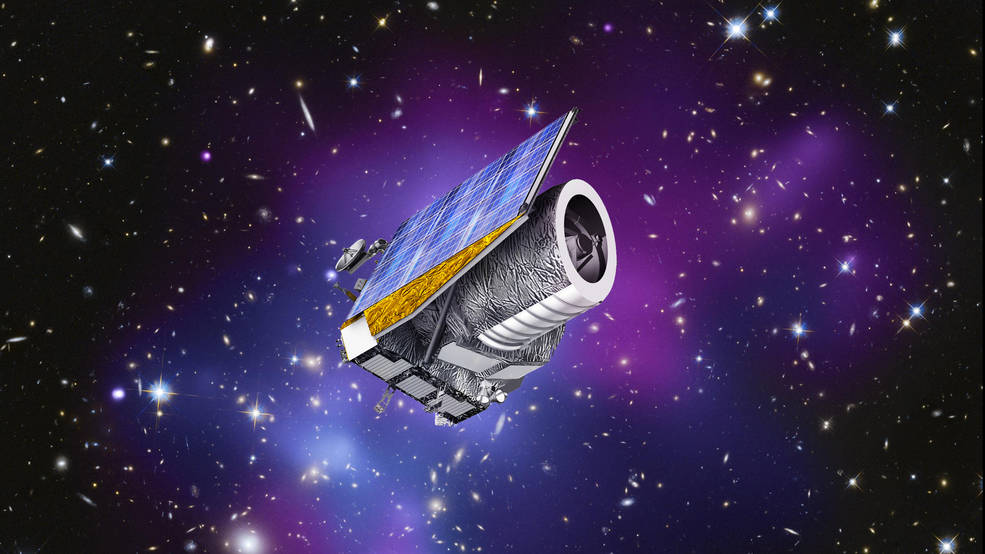ESA’s space missions Euclid and Hera will be launched in 2023 and 2024

Hera is the first planetary defence mission
The European Space Agency’s (ESA) Council recently approved that Euclid and Hera space missions, in which researchers from the Institute of Space Studies of Catalonia (IEEC) at the Institute of Space Sciences (ICE-CSIC) participate, will be launched with SpaceX Falcon 9 vehicles in 2023 and 2024, respectively.
 Left: Artist's impression of the Euclid spacecraft. Credit: ESA/ATG medialab (spacecraft); NASA, ESA, CXC, C. Ma, H. Ebeling and E. Barrett (University of Hawaii/IfA), et al. and STScI (background)
Left: Artist's impression of the Euclid spacecraft. Credit: ESA/ATG medialab (spacecraft); NASA, ESA, CXC, C. Ma, H. Ebeling and E. Barrett (University of Hawaii/IfA), et al. and STScI (background)
Right: Illustration of the DART mission. Credit: NASA/Johns Hopkins APL
Euclid mission
Euclid is an ESA mission which will map the geometry of the Universe and better understand their dark matter and dark energy mysterious components. The mission will investigate the geometry of the Universe and the evolution of cosmic structures by measuring shapes and shifts of galaxies and clusters of galaxies out to distances when the Universe was 10 billion years younger. In this way, Euclid will cover the entire period over which dark energy played a significant role in accelerating the expansion of the Universe.
Researchers from the ICE-CSIC and IEEC’s members Francisco J. Castander, Martin Crocce, Pablo Fosalba and Enrique Gaztañaga are members of the Euclid Consortium. Castander is a member of the Euclid Consortium Board where he served two years as Chair. He is also a member of the ESA Euclid Science Team. They are responsible, together with researchers from the Institute of High Energy Physics (Institut de Física d'Altes Energies, IFAE), of delivering the Filter Wheel Assembly (FWA) of the Near Infrared Spectrograph and Photometer (NISP). The IEEC’s researchers in the ICE-CSIC lead the Simulation Organization Unit and are deputy coordinators of the Photometric Redshift Organization Unit of the Science Ground Segment. The redshift is an indicator that the galaxies are moving away from each other. They also lead the Cosmological Simulations Science Working Group and actively participate in other Science Working Groups.
Hera mission
Hera is a ESA flagship planetary defender mission visiting the binary asteroid Didymos as a follow-up of the Double Asteroid Redirection Test (DART) mission of the NASA and Johns Hopkins Applied Physics Laboratory. The DART is the first planetary defence dedicated mission. On 27 September 2022, it successfully deflected an asteroid in a kinetic impact. Its target was a 160 metres sized asteroid called Dimorphos, currently being a satellite of a 760 metres in diameter asteroid named Didymos. Both asteroids are currently classified as Potentially Hazardous Asteroids and require further study because they can be considered prototypes of bodies that might be a source of risk for humans in case of a future collision.
Hera will map Didymos and Dimorphos in high resolution to study the impact crater and its consequences on Dimorphos. In addition, Hera will demonstrate new technologies to study asteroids like e.g. autonomous navigation under low gravity conditions, the use of state-of-the-art spectrometers, multispectral cameras, and radars to characterise the surface composition, mineralogy and inner structure of the Didymos system. In summary, Hera will be the first probe to rendezvous with a PHA binary system with unique scientific instrumentation capable of developing future strategies of planetary defence.
Josep M. Trigo-Rodríguez, principal investigator of the Meteorites, Minor Bodies and Planetary Sciences group at the ICE-CSIC and member of the IEEC, participates in both DART and Hera investigation teams providing key expertise in the study of the physico-chemical properties of asteroids and their rock-forming materials, usually arrived to the Earth as meteorites, or returned samples.
Press release prepared in collaboration with the Communication Office of the Institute of Space Sciences (ICE-CSIC).
Main Image
Caption: Artist's impression of the Euclid spacecraft.
Credits: ESA/C. Carreau
Links
– IEEC
– ICE-CSIC
– Missió DART
– Missió Hera
More information
The Institute of Space Studies of Catalonia (IEEC — Institut d’Estudis Espacials de Catalunya) promotes and coordinates space research and technology development in Catalonia for the benefit of society. IEEC fosters collaborations both locally and worldwide and is an efficient agent of knowledge, innovation and technology transfer. As a result of 25 years of high-quality research, done in collaboration with major international organisations, IEEC ranks among the best international research centers, focusing on areas such as: astrophysics, cosmology, planetary science, and Earth Observation. IEEC’s engineering division develops instrumentation for ground- and space-based projects, and has extensive experience in working with private or public organisations from the aerospace and other innovation sectors.
IEEC is a private non-profit foundation, governed by a Board of Trustees composed of Generalitat de Catalunya and four other institutions that each have a research unit, which together constitute the core of IEEC R&D activity: the Universitat de Barcelona (UB) with the research unit ICCUB — Institute of Cosmos Sciences; the Universitat Autònoma de Barcelona (UAB) with the research unit CERES — Center of Space Studies and Research; the Universitat Politècnica de Catalunya · BarcelonaTech (UPC) with the research unit CTE — Research Group in Space Sciences and Technologies; the Spanish Research Council (CSIC) with the research unit ICE — Institute of Space Sciences. The IEEC is a CERCA (Centres de Recerca de Catalunya) center.
Contacts
IEEC Communication Office
Barcelona, Spain
E-mail: comunicacio@ieec.cat
